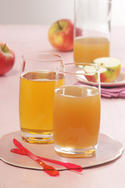
Juice processing range from simply squeezing a single fruit type at home to international companies exporting blended juices world-over. These juice products are produced in highly technical juice processing plants, processed and packed into sophisticated packaging.
Juices can be sold as the juice of a single fruit (e.g. orange juice) or can be blended with other juices to enhance its sweetness, adjust the acidity, colour or taste and to increase the nutritional variety of the product.
Juiced products are classified according to the volume of real fruit juice it contains.
Classification of Fruit Juices
The classifications of fruit juice, according to the South African Fruit Juice Association (SAFJA), are as follows:
‘Fresh fruit juice’ contains 100% juice with no additives allowed. It must be sold within 2 hours of extraction.
‘Unsweetened fruit juice’ is 100% juice with permitted additives allowed.
‘Fruit nectar’ should contain a minimum percentage of fruit juice, and the volume varies for different fruit.
For example, a minimum of 50% juice is required for pineapple, orange, naartjie and apple. A minimum of 35 - 40% juice is required for apricot (35%), peach and pear (40%) while granadilla, guava, banana, blackcurrant, papaya, litchi and mango fruit nectar requires at least 20% to be classified as such. Lemon and lime juice should make up at least 12.5% of a blend to classify as a ‘fruit nectar’.
‘Fruit squash’ should contain a minimum of 24% juice in undiluted form and 6% (minimum) in diluted form. A ‘fruit drink’ should contain at least 6% juice.
A ‘fruit flavoured drink’ usually contains less than 6% fruit juice.
Types of Juice
Well-known and popular juices such as orange, grape, pineapple, apple, tomato and blends are well established, but tropical juices (e.g. coconut water, açaí and goji berry), vegetable juice (e.g. cucumber and wheatgrass) and juice blends are growing in popularity.
Some juiced products are used for medicinal purposes - examples include Aloe ferox juice and makrut lime juice.
Juice may be clarified to extract solids and yield a cleared, brighter end-product, but many health-conscious consumers may prefer cloudy juices with natural fibre. Popular clear juices are apple, grape and berry juices like cranberry.
Juice may be carbonated to add fizz or used as an ingredient in sauces, cocktails, marinades and mixed-fruit drinks to increase flavour and acidity (e.g. lime and lemon juice).
Cold-pressed juice is the healthiest form of juice. During this process, the juice is extracted with a hydraulic press. In contrast, when a centrifugal press is used, the blades cut and mash the product, leading to an increase in temperature and exposing the fruit to more oxygen. Oxygen leads to oxidation for which the B-vitamins and vitamin C are especially sensitive.
Cold-pressed juices retain more of a fruit’s or vegetable’s vitamins and minerals and often don’t contain added artificial sweeteners or preservatives used bottled or pre-packed juice.
Juice Blends
Not all fruits are suitable for conventional fruit juice and may turn into a thick puree when juiced. Puree from fruit such as pear, banana, apricots and mangoes needs to be diluted with water or other juice to give it drinkable consistency. These thick fruit nectars are often used in smoothies, cocktails, ice creams and other value-added products.
Some juices are more suitable to use in blends due to taste, texture or bitterness – beetroot, carrot and Aloe ferox comes to mind.
Other juices are added to blends to add flavour, acidity, colour, taste and to the final blended product. While adding certain juices may also have a preservative effect; rhubarb juice (10 - 20%) may limit the browning of apple juice.
By Marinda Louw